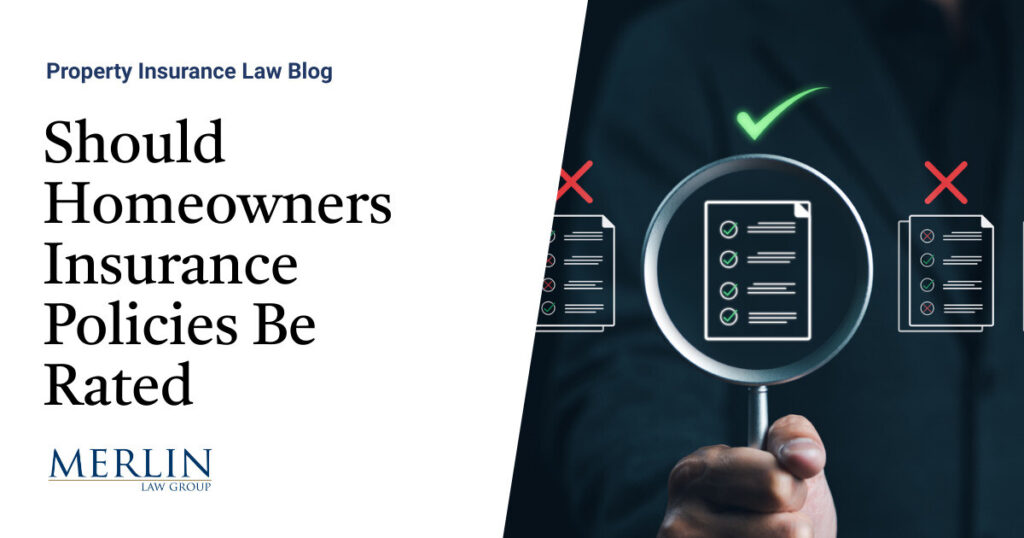Should Homeowners Insurance Policies Be Rated? A Proposal for Improving the Residential Property Insurance Market at the Point of Sale

The purchase of residential insurance is unlike the purchase of any other expensive product. The seller does not let you see what you purchase in advance. Instead, residential insurance purchasers get a vague description of the policy conditions with a warning that the undisclosed language in the real product controls the rights of the parties. Further, if you cancel immediately after the real product is provided, there is usually a 25% penalty you still have to pay. The bottom line is that residential insurance consumers are at the mercy of the selling insurance companies at the point of sale and the delivery of performance after a loss occurs regarding the quality of the product that is purchased.
Distinguished Professor Emeritus Jay Feinman makes a proposal to help resolve this residential insurance marketplace problem. In an article just published in the Connecticut Insurance Law Journal, “Improving the Market for Homeowners Insurance,” 1 Feinman argues for the following changes:
1. Full-Text Publication
Objective: Increase transparency by making the full text of insurance policies publicly available. This measure would require insurance companies to upload the complete terms and conditions of their policies to a publicly accessible database. This step aims to eliminate the information asymmetry where consumers often purchase insurance without fully understanding the coverage specifics. Regulators could ensure that this information is updated and accurately reflects current offerings.
2. Coverage Summaries
Objective: Provide consumers with easy-to-understand, standardized summaries of insurance policies. Coverage summaries would act as a concise reference tool, highlighting key aspects of insurance policies such as exclusions, limits, and special conditions. These summaries would be formatted consistently across all insurers to facilitate direct comparison by consumers, aiding them in making more informed decisions.
3. Claims Quality Summary
Objective: Develop summaries that report on insurers’ performance in handling claims. This proposal suggests compiling data on how quickly and fairly insurers settle claims. These summaries would include metrics such as the average time to settle claims, the percentage of claims disputed by customers, and satisfaction ratings from customers. By making this information public, consumers can choose insurers not only based on price and coverage but also on service quality.
4. RU InsureScore
Objective: Rate insurers similarly to how Consumer Reports evaluates consumer products. RU InsureScore would provide a scoring system for insurers based on extensive reviews and analyses of their policy offerings and claims handling efficiency. This score would help consumers quickly assess the quality of insurers, similar to ratings for electronics or automobiles, promoting better competition among insurers.
5. Online Tools
Objective: Create comprehensive, easy-to-use online platforms for insurance comparison. These tools would aggregate data from various sources about policy terms, prices, and insurer ratings. Ideally, these platforms would allow consumers to filter and compare different insurance products based on their specific needs and preferences, making the shopping process more tailored and efficient.
6. Education and Awareness
Objective: Enhance consumer knowledge and understanding of insurance products. This involves a concerted effort by state insurance departments to launch educational programs and resources that help consumers understand the nuances of homeowners insurance. Topics could include the importance of various types of coverage, how to file a claim, and how to read and interpret insurance documents.
7. Legislative Changes
Objective: Support the enforcement of transparency and consumer protection through new laws. This resolution calls for legislative backing to enforce the publication of insurance policy texts and performance data. It could also involve creating new laws that mandate insurers to provide all proposed resolutions, ensuring that these measures have the legal support to be implemented effectively and uniformly across the industry.
Feinman argues that improving access to information and enhancing regulatory requirements for transparency and consumer education will lead to a more competitive and consumer-friendly insurance market. The proposed measures aim to empower consumers to make better-informed decisions and ensure that they receive fair treatment from insurance providers.
Does this really have a chance to happen? Feinman cited another study by Professor Daniel Schwarcz, which suggests that this is another law review idea that is headed nowhere fast:
A decade ago, Daniel Schwarcz summed up regulators’ actions in making information available to consumers as ‘transparently opaque:’ ‘In both property/casualty and life insurance—the two insurance arenas that the states predominantly regulate—lawmakers and regulators have routinely resisted transparency-oriented consumer protections . . . .’ The situation today is largely unchanged, especially with respect to the terms of coverage.
I previously noted, in “Do You Need Help Determining What the Best Homeowners Insurance Policy Is to Purchase? Why Don’t Insurance Regulators Do a Better Job Showing Which Policies Are Best?” that Feinman is indirectly calling out insurance regulators who are falling down on their jobs by not publishing a rating system.
Unless the media picks up on these ideas and exposes “the revolving door” of insurance industry influence over the insurance regulators, these ideas may not develop into meaningful reforms. So, let’s see what we can do to help educate the media about this important issue.
Thought For The Day
The lack of transparency in insurance pricing and coverage options is a significant barrier for consumers trying to find the best policy for their needs.
—Robert Hunter (Director of Insurance, Consumer Federation of America)
1 Jay M. Feinman, Improving the Market for Homeowners Insurance, 30 Conn. Ins. Law J. 169 (2024).







